Introduction: Why Are We Drawn to the End of the World?
There’s a haunting beauty in a crumbling pier, a compelling mystery in a rain-slicked, neon-lit alley, and a strange comfort in a misty, forgotten landscape. For years, these aesthetics were confined to film screens and the pages of sci-fi novels. Now, they’re moving into our living rooms.
This isn’t a trend about pessimism; it’s about psychological exploration. Dystopian and cinematic decor allows us to safely confront themes of decay, resilience, and mystery. It connects us to powerful narratives and asks profound questions about time, humanity, and our place in the world.
This is Dystopian Decor: a deep dive into the four archetypes of this captivating style. We’ll explore the psychology behind the aesthetics and show you how to use printable art to build a space that is not just decorated, but deeply storied.
Archetype 1: The Post-Apocalyptic Landscape – Beauty in Decay
Psychological Appeal: A contemplation of impermanence and the resilient power of nature. It’s Memento Mori on a global scale, reminding us of the fleeting nature of civilization and the enduring beauty of the earth.
This aesthetic isn’t about fear; it’s about awe. It’s the visual representation of the phrase “this too shall pass,” showing a world where humanity has receded and nature begins to reclaim its dominion. The mood is haunting, melancholic, yet profoundly peaceful.
Your Art Prescription:
‘Decay of Beauty’ (Lone Tree in Buttermere): The title itself is the philosophy. This artwork shows a classic, beautiful landscape undergoing a process of erosion and transformation. It’s a reminder that beauty is not static; it can be found in distortion, age, and the relentless passage of time.
‘Environmental Art’ (The Polar Bear): This is the quintessential post-apocalyptic narrative. A lone polar bear sits atop a mound of trash, the ruins of a city silhouetted against a sunset. It’s a powerful, tragic, and beautifully composed piece that speaks directly to themes of consumption, loss, and a world changed forever.
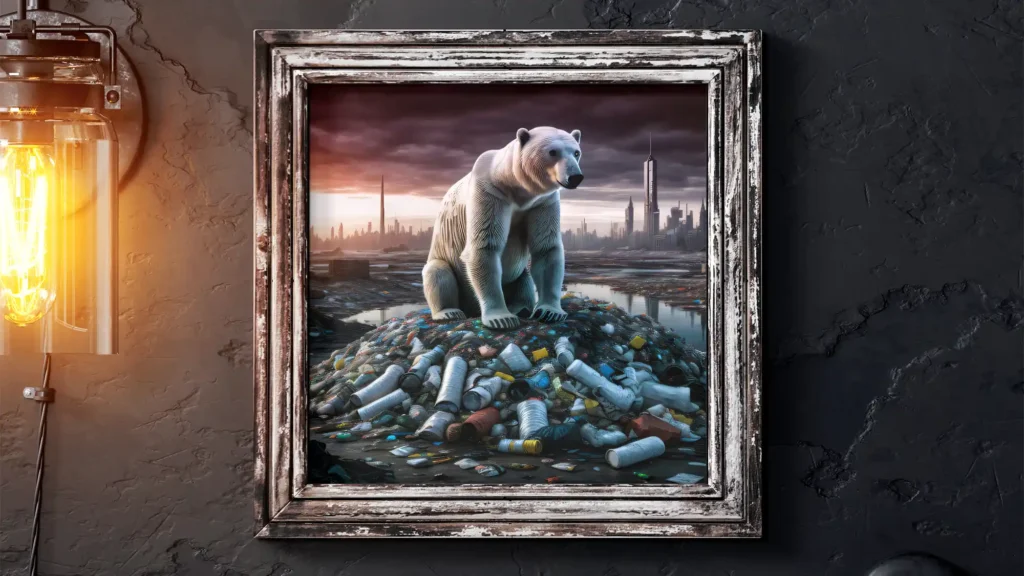
‘The End’ (Holy Island Coast): Captured at dusk with a palpable sense of “impending doom,” this photograph is the moment before the credits roll. It’s less about the decay after the fact and more about the chilling calm of the final moment, making it a deeply contemplative piece.
‘The Passing of the Day’ (Steetley Pier): This piece embodies ethereal decay. It captures the remnants of a forgotten industry, with the pier standing as a ghostly legacy. The ebbing tide and fading light parallel the decline, creating a beautiful, sorrowful, and ultimately peaceful elegy for a lost way of life.
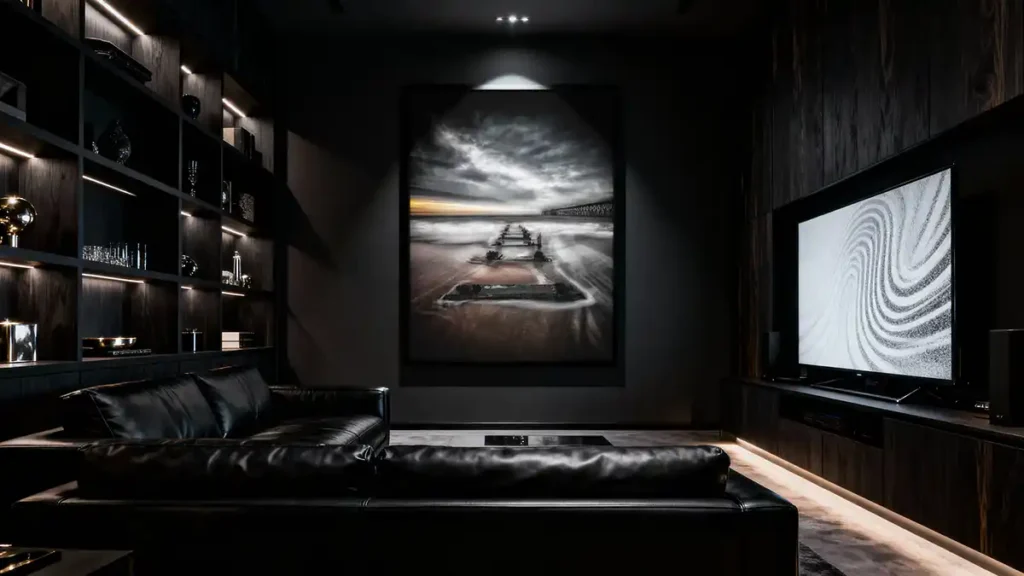
Archetype 2: The Cyberpunk & Sci-Fi City – Neon and Noir
Psychological Appeal: The tension between humanity and technology, the allure of the futuristic metropolis, and a sense of hyper-stimulated mystery. This is the aesthetic of the “high-tech, low-life” future, where awe and alienation coexist.
This aesthetic thrives on contrast: the sleek and the gritty, the digital and the decaying, the vibrant neon glow against the inky blackness of a rain-slicked street. It’s a world of endless night, layered with information, and brimming with hidden stories. Decorating with this style injects a space with dynamic energy and a sense of being on the edge of tomorrow.
Your Art Prescription:
‘High Level Bridge Time Travel‘: This piece leans into pure sci-fi wonder. The abstract time travel effects lighting up the iconic bridge create a portal to another dimension. It’s for those who want their decor to speak of exploration, paradox, and the boundless possibilities of science fiction.
‘Metropolis’ International Poster: This is the genesis of the entire genre. Fritz Lang’s vision of a towering, faceless city dominated by technology remains the most iconic and haunting dystopian imagery ever created. This poster isn’t just art; it’s a piece of cinematic history that anchors the entire cyberpunk aesthetic.
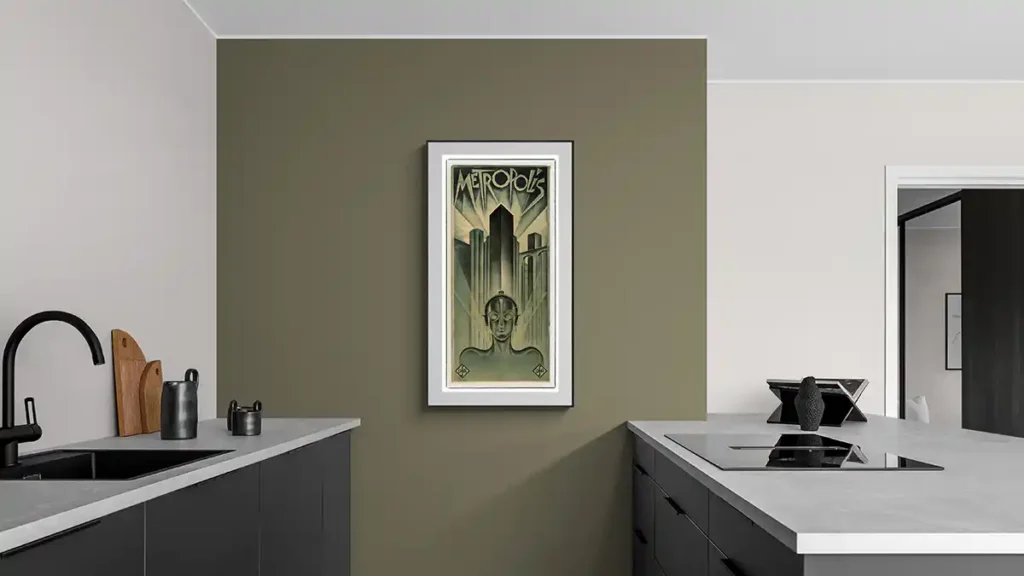
‘Faded Memories – The Glasshouse’ Gateshead Printable Art: With its special inky colour effect and organic, eroded look, this piece by Michael Paul Bennett embodies the “decaying future” trope. It’s as if a sleek, modern structure has been weathered by time and digital corrosion, creating a powerful visual of a future that was never fully maintained.
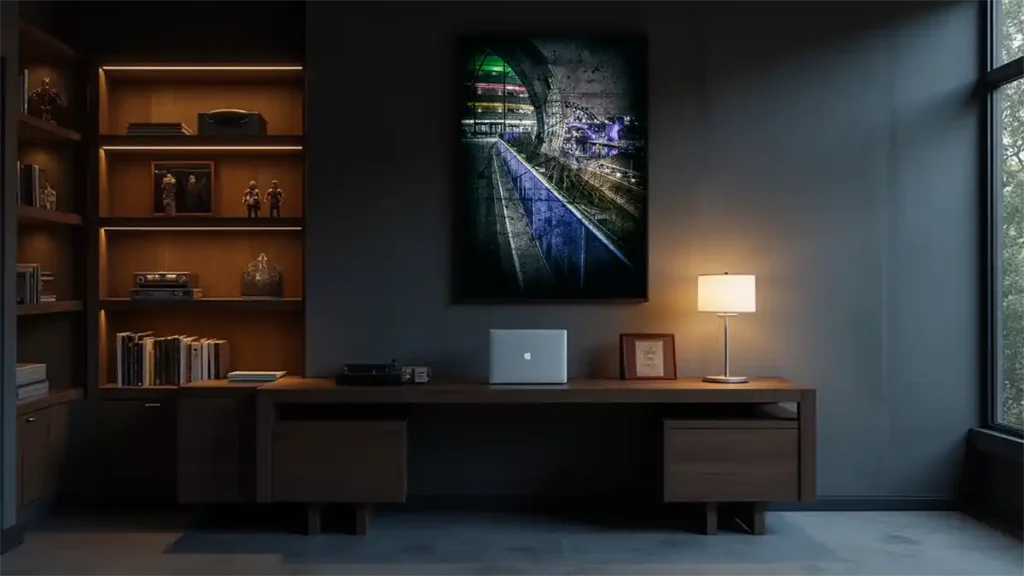
Archetype 3: The Gothic & Supernatural – Dark Academia & Folk Horror
Psychological Appeal: Tapping into ancient fears, folklore, and the allure of the mysterious and occult. This style is less about a future collapse and more about the shadows that have always lingered at the edge of the village, in the forgotten graveyard, or within the human soul. It’s about atmosphere, storytelling, and connecting to a darker, richer past.
This aesthetic draws its power from tradition, superstition, and the uncanny. It’s the feeling of a whispered legend, the chill of a ghost story, and the elegant morbidity of a bygone era. Decorating with this style creates a space that feels layered with history, secrets, and a touch of the macabre.
Your Art Prescription:
‘Vintage Nun with a Peacock‘: This piece is deeply uncanny and unique. The combination of the religious figure, the exotic bird, and the 1920s stylization creates a narrative that is both elegant and deeply unsettling. It belongs in a collection that leans into “elevated horror” and the bizarre.
‘Dark Academia Scarecrow‘: This is folk horror in its purest form. The scarecrow, a figure meant to protect, becomes an object of unease, staring back from across a field. Rendered in a vintage photographic style, it feels like a recovered relic from a unsettling past, perfect for creating a sense of rustic dread.
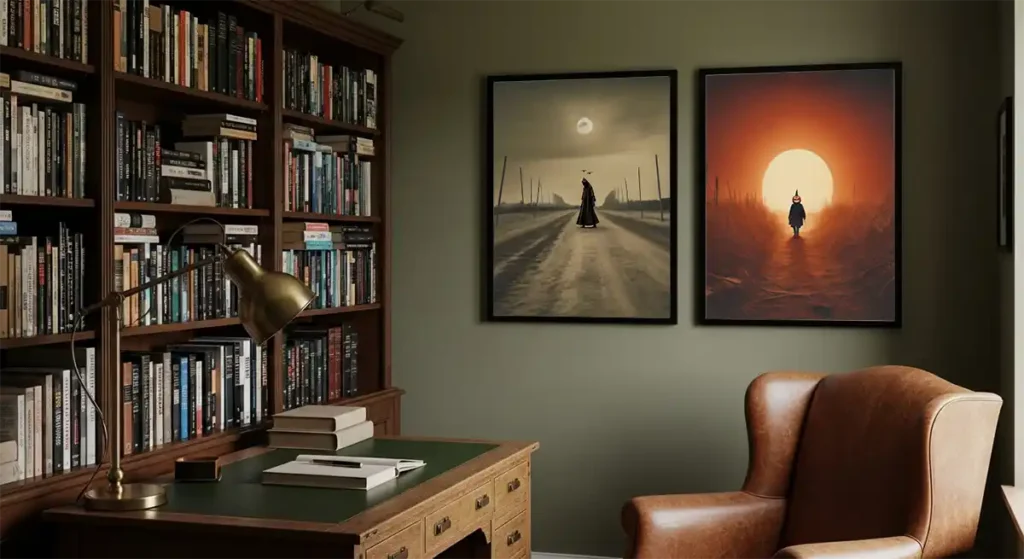
‘Grim Reaper’ Digital Download: The iconic personification of death, captured as a solitary figure down a deserted road. This is the ultimate memento mori, not for a futuristic world, but for a timeless one. It’s a stark, powerful reminder that underpins the entire gothic tradition.
‘Colorful Floral Skull‘: A modern, surreal twist on Gothic memento mori. The vibrant flowers growing from the skull don’t negate death; they celebrate the cycle of life and decay in a beautifully grotesque way. It’s a piece that bridges classic symbolism with a more contemporary, psychedelic sensibility.
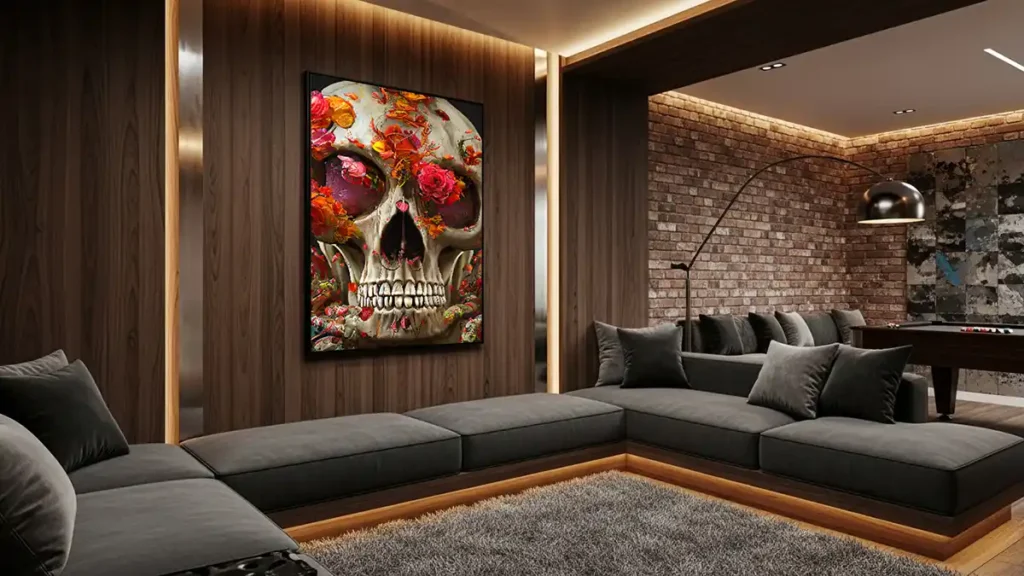
Archetype 4: The Abstract & Surreal – Internal Dystopias
Psychological Appeal: Representing internal chaos, psychological breakdown, or the unsettling feeling of a distorted reality. If the other archetypes show a broken world, this one shows a broken mind or a fractured dimension. It’s dystopian on a personal, subconscious level.
This aesthetic moves beyond literal scenes to evoke emotion and unease through form, texture, and dissonance. It’s for those who find dystopia not in a skyline, but in a feeling—the anxiety of systems failing, the horror of perception shifting, or the beauty in chaos. This art doesn’t tell a story; it invites you to project your own.
Your Art Prescription:
‘Thingvellir National Park Cracks‘: A powerful, metaphorical image where the cracks in the earth represent the fundamental fault lines in a psyche or a reality itself.
‘Tortured Minds’ by Michael Paul Bennett: This is the definitive piece for the internal dystopia. It moves beyond metaphor into direct representation. The distorted, bright orange and yellow shapes against the black background are the “chaos, confusion, and pain” of mental illness itself. The spiralling forms visually depict the “downward spiral,” making the internal struggle terrifyingly visible.
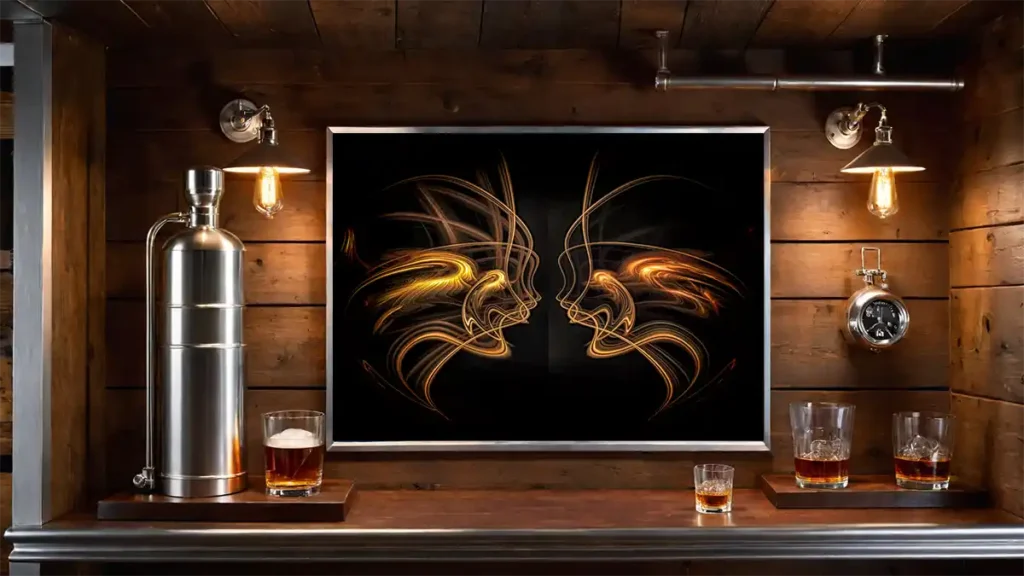
‘The Angel of Despair‘: This abstract photograph of a fallen angel complements “Tortured Minds” by representing the emotional consequence—the hopelessness and anguish that can accompany internal turmoil.
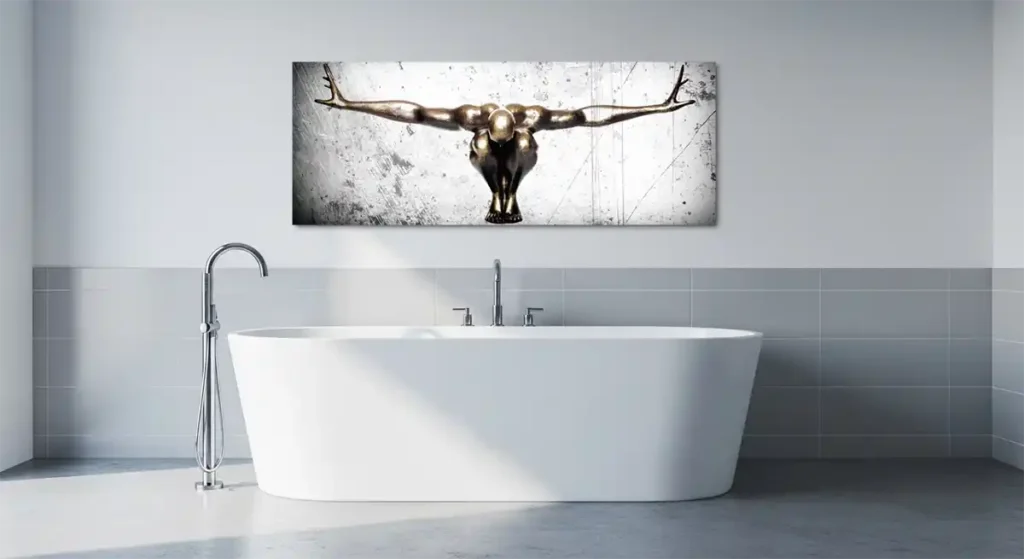
‘Industrial Paris in Shadows‘: The “film noir style” transforms the architecture into a study in psychological tension, like the inner workings of a vast, impersonal mind.
A Practical Guide: Curating Your Dystopian Narrative
Building a dystopian space isn’t about creating a depressing environment; it’s about intentional curation. Here’s how to blend these archetypes to create a cohesive and powerful story.
Embrace the Printable Advantage: This aesthetic is deeply personal. The printable art model is its perfect partner. It allows you to experiment with these powerful themes, swap narratives as your taste evolves, and build your gallery without the waste or commitment of mass-produced decor. You are the curator of your own cinematic experience.
Choose Your Dominant Archetype: Start with the theme that resonates most. This will be the focal point of your room. Is it the melancholic peace of a Post-Apocalyptic landscape over your sofa? Or the tense energy of a Cyberpunk cityscape in your office?
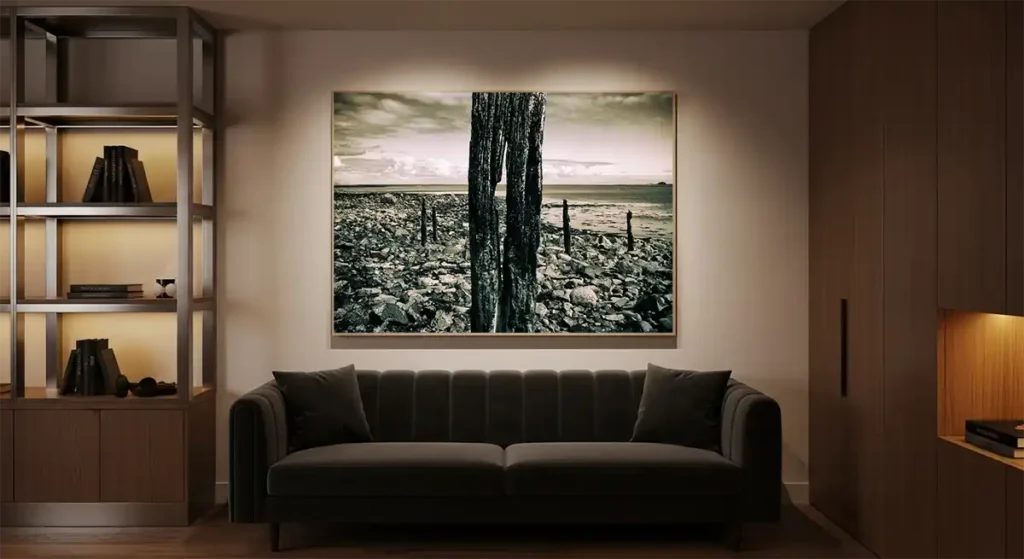
Layer with a Secondary Theme: Add depth by introducing a piece from a complementary archetype.
Pair a Post-Apocalyptic landscape with a Gothic memento mori piece to emphasize themes of time and mortality.
Place a surreal Abstract piece beside a Cyberpunk cityscape to suggest the psychological impact of that world.
Unify with a Cohesive Palette: The thread that ties these themes together is often a restrained color palette. Stick to monochrome, sepia, or muted tones with occasional strategic bursts of color (like a neon sign or the fiery orange in ‘Tortured Minds’) to create focus.
Conclusion: Build Your Cinematic Sanctuary
Dystopian decor is more than a dark aesthetic; it is a form of storytelling. It allows us to curate narratives of resilience, mystery, and introspection on our walls. Whether you are drawn to the silent poetry of a Post-Apocalyptic Landscape, the electric buzz of a Cyberpunk City, the ancient whispers of a Gothic tale, or the raw expression of an Internal Dystopia, you are engaging in a deeper dialogue with your space.
Your home is your sanctuary, and sometimes, a sanctuary is a place to safely explore the shadows.
Ready to define your narrative? Explore the collections below to begin building your cinematic world.
[Shop the ‘End of Days’ Collection] | [Shop Abstract Art] | [Shop All Black & White Photography]
